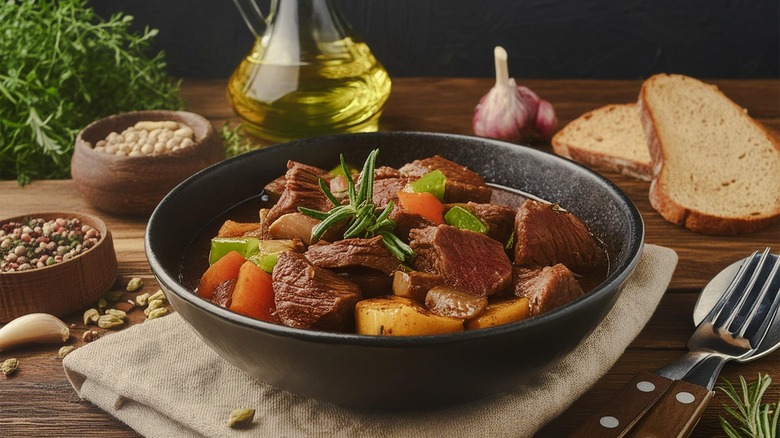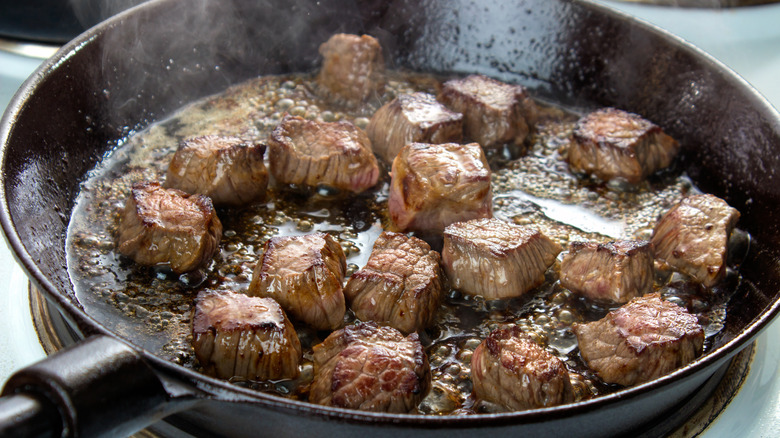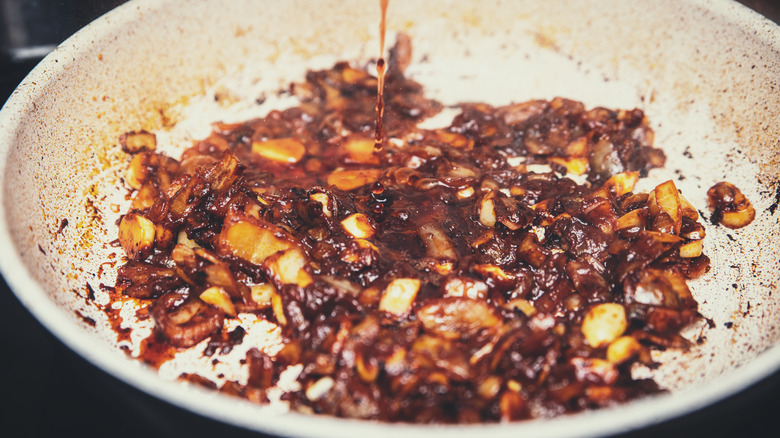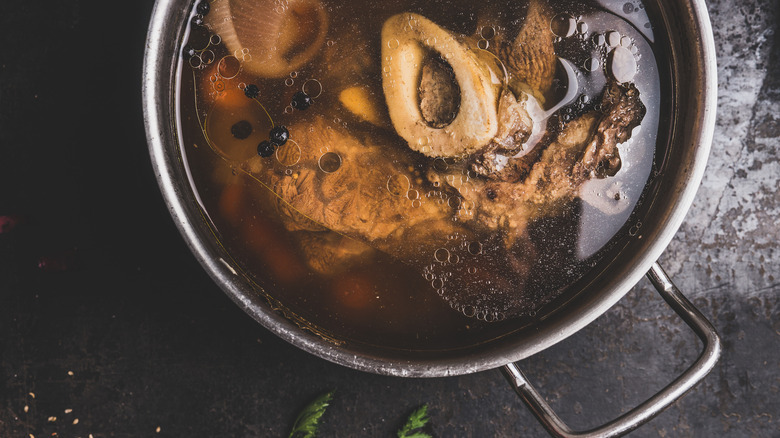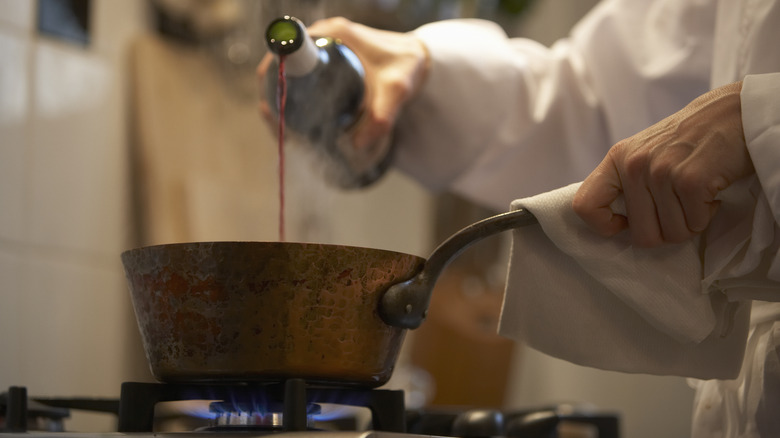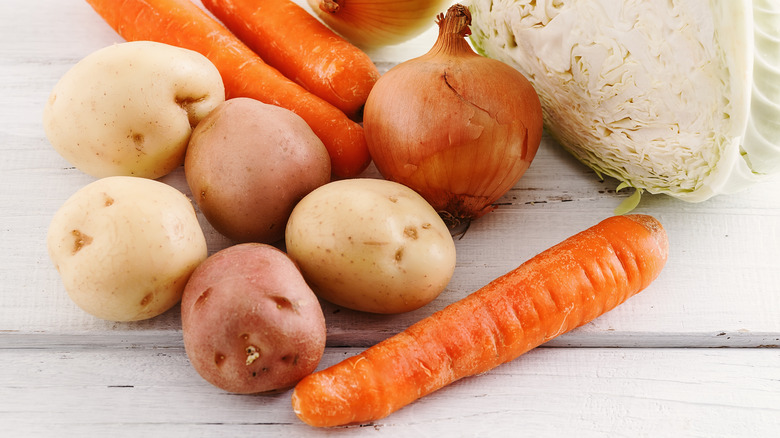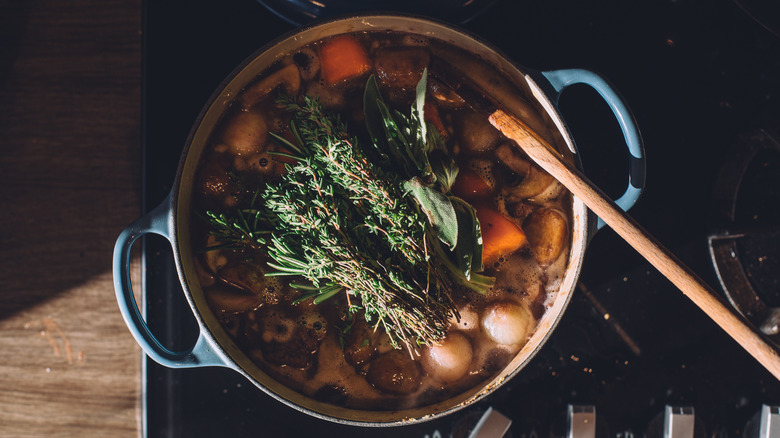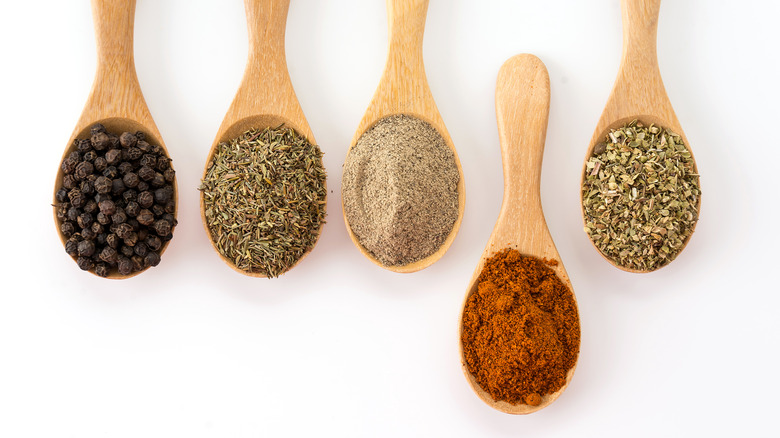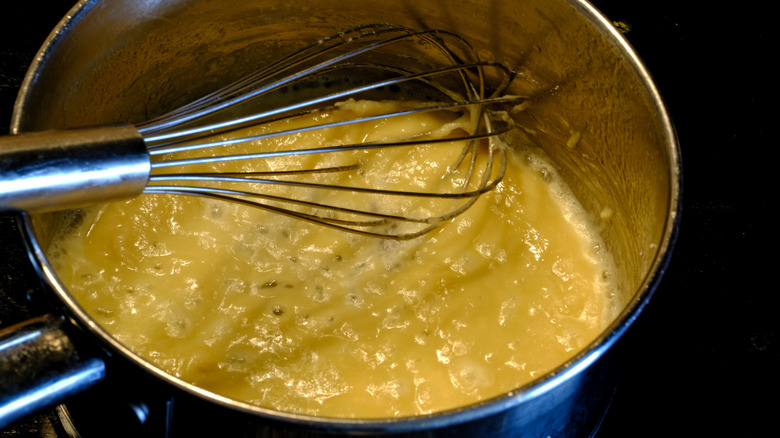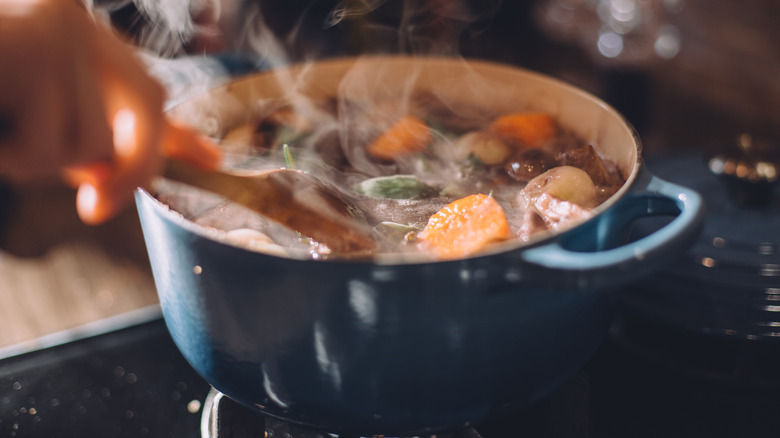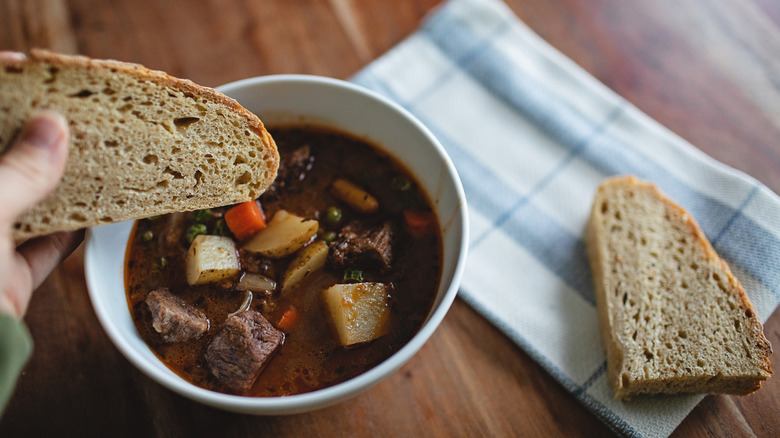11 Easy Ways To Upgrade Your Basic Beef Stew
Hearty and nourishing, beef stew is a favorite comfort food served in a variety of forms around the globe. At its most basic, the classic dish consists of chunks of beef — usually a tough cut like chuck, round, or brisket — and a variety of vegetables. The ingredients are then slow-cooked in liquid until the beef becomes nice and tender.
While, in theory, preparing a beef stew isn't exactly rocket science, the reality is that there are many mistakes that can impact both the flavor and texture of the dish. These aren't necessarily big things but small, frequently overlooked details that can have a substantial impact on the final outcome. Minute oversights, such as failing to sear the beef or not paying attention to the cooking time, can lead to a substandard dish.
Whether you're a seasoned home chef who has prepared dozens of stews or a newbie in the kitchen, we are here to help. Before you make your next stew, take a look at our list of some easy ways to elevate this iconic dish to the next level!
1. Brown the beef before slow cooking
While most of us know that a good stew can take hours to cook on the stove, not all of us are aware that there is one crucial step that can make or break a stew even before the meat goes into the pot. Searing the beef prior to simmering it not only renders the meat golden brown but can also add an unforgettable deep and rich flavor to the final dish.
To sear beef, cut it into cubes and pop it on a piping hot skillet with a little oil. It's important to sear the beef at a high temperature of at least 285 degrees Fahrenheit in order to trigger the Maillard reaction, the process that's responsible for creating the complex flavors that enhance the overall taste of the stew.
Sear the beef cubes until they are brown on all sides. If you start to worry about overcooking the beef, don't. Braised meat is normally thoroughly cooked and the slow-cooking process involved in creating a stew will ensure that it turns tender. That said, it's important not to overcrowd the pan during the searing process, as this will steam the beef and fall to form that delicious crust.
2. Deglaze the pan
The act of deglazing a pan is super simple, so it's surprising that so many people miss out on this key step. Frank Proto, Director of Culinary Operations at the Institute of Culinary Education, explained why deglazing can add flavor to dishes in an interview with Mashed. "After you caramelize meat, there's often little bits of meat and caramelized juices stuck to the bottom of the pan," he explained. It's precisely these little morsels of goodness — known as fond — that are packed with concentrated flavor.
To begin deglazing, remove the seared chunks of beef and any veggies or other ingredients from the pan and set aside. With the pan on gentle heat, add a little wine, liquor, or beer to the pan to release the fond from the bottom of the pan. If you're not overly keen on boozing things up, you can also use stock, juice, or vinegar instead of alcohol. If in a pinch, you can also deglaze your pan with a simple splash or two of water. Whatever liquid you opt for, once it's in the pan, grab a spatula or a wooden spoon and scrape the brown bits from the bottom of the skillet. Finally, remember to add the fond to the rest of your stew.
3. Use the right stock or broth
A quality stew is made with tender chunks of beef that have been braised in liquid over an extended period of time. While the easiest option for this liquid is water, it's not precisely the best one. Although water is a life-saver when it comes to quite a few recipes, in this case, it's definitely not the most flavorful choice.
So, which liquid works best for imbuing beef with the rich, savory flavors that make this classic dish so satisfying? The best option by far is homemade broth or stock. For those who remain uninitiated to the process, stock is normally made by simmering bones until they release collagen. Broth is generally made by simmering meat (such as that leftover from a meal).
Some home chefs prefer to use beef stock or broth, while others swear by making beef stew with chicken bouillon, as it's not as strong in flavor. According to some home chefs, if you need to use store-bought stock, opt for chicken stock as pre-made beef stock can taste tinny.
4. Add a dash of red wine
When making beef stew, alcohol can be used for more than just deglazing the pan after you've seared the beef. Stirring a little red wine into your stew as it simmers can add a much welcomed burst of flavor and complexity to the dish. Texture can come into play, too. Since beef stew recipes usually call for tough cuts of beef, such as chuck, roast, or round, pouring a dash of wine into the stew may also help to tenderize the meat. This is because the acidity in wine can work to down the connective tissues in the beef.
Just as with pasta sauces, stews don't require expensive wine. Whatever type of wine you opt for — be it Shiraz, Pinot, Merlot, or some other variety — the price point of the drop won't necessarily affect the taste of the final dish.
And in case you're wondering whether stews made with alcohol are safe for children, they most definitely are. The great majority of the alcohol will burn off during the cooking process (though trace amounts may remain). Of course, this is assuming that you only add a splash of the stuff. Adding too much red wine to the dish isn't advisable anyway, as it can make the stew overly acidic.
5. Add the veggies at the right time
When it comes to cooking, timing is everything. Since stews are normally slow cooked and different ingredients have varying cooking times, adding everything to the pot at the start may result in a mess of undesirable textures. More specifically, some ingredients may overcook and become unpleasantly mushy while others may turn out undercooked or even become overly tough.
In addition to beef, vegetables play an important role in building the flavor and texture of a stew. Some of the favorites here include potatoes, carrots, and aromatic onions. Since veggies typically cook much faster than beef (especially the tough cuts often used in a stew), adding both to the mix at the same time could be disastrous.
Instead, vegetables should join the pot after the beef and during the simmering process, depending on the veggie in question and its size. For instance, harder and larger vegetables such as carrots may need around an hour to cook while small and soft veggies like peas should be thrown into the pot only minutes before you take it off the stove.
6. Create a bouquet garni
Originating in French culinary tradition, a bouquet garni is a bundle of fresh or dried herbs that have been tied together with a string or baker's twine. Alternatively, if you're using crushed herbs or peppercorns, they can also be placed inside a sachet made from cheesecloth. The beauty of bouquet garni lies in the fact that you can easily remove it from the stew once the herbs have flavored the dish. Using bouquet garni instead of loose herbs ensures that your stew won't come with any unappetizing pieces of stems or leaves.
While bouquet garni can be made with any combination of herbs, it's best to avoid mixing fresh and dry herbs. This is because dried spices should be added earlier during the cooking process to fully release their flavors, whereas fresh herbs can join the pot much later. Some of the most popular dried herbs typically added to stews include thyme, bay leaves, and rosemary. Meanwhile, fresh herbs that can be easily bunched together into bouquet garni include parsley, tarragon, and dill.
7. Mix in some aromatics and spices
Without a good dose of seasoning, stews can often turn out underwhelming and bland. Luckily, layering aromatics can easily take care of this issue, provided that you choose ones that suit your taste. Some of the most popular aromatics used in stews include onion, garlic, carrots, celery, and leeks. To best bring out their flavor, try sautéing the aromatics in the fat that's left over from searing the beef before adding them to the stew.
When it comes to spices, it pays to experiment beyond salt and pepper. Just keep in mind that salt is best added early in the cooking process. This is because salting the stew after it's already cooked can overwhelm the dish's flavor profile. Incorporating other spices such as paprika, onion powder, garlic powder, and cumin can complement the other ingredients in the stew. Those who enjoy their beef stew with a kick can also add a little chili powder or cayenne pepper into the mix for a bit of heat.
8. Add some umami notes
Most people are familiar with some of the basic tastes, namely sweet, sour, salty, and bitter. However, there is also a fifth core taste that can transform a fish: umami. Described by Japanese scientists in 1908, umami is both rich and savory in flavor. The fact that umami is often translated from Japanese as "essence of deliciousness" should be enough to make anyone realize that this is a flavor beef stew simply can't afford to miss.
Umami flavor is present in many food items, most of which you could easily find in your kitchen right now. These include cheese, mushrooms, meat, fish, tomatoes, onion, and broccoli. The choice of what to include in your stew is yours!
One especially umami-rich ingredient that can do wonders for your beef stew is fish sauce. The condiment is best added after all your ingredients are already happily simmering in the pot. We're not talking about large quantities here — around a teaspoon of fish sauce per pot should be plenty. Another — perhaps surprising — umami ingredient that can elevate beef stew is anchovies. To deepen the flavor of the stew without overpowering the other ingredients with this notoriously pungent ingredient, only use one or two of the little morsels. If needed, you always can add more later.
9. Thicken the stew the right way
If your beef stew turns out overly watery, there's no need to despair. There are many ways you can remedy this common problem, though we'll admit that some are better than others. One of the best ways to thicken a stew is by adding a few potatoes to the pot. This is because the starch in potatoes is often enough to thicken the dish. When selecting potatoes for the stew, opt for ones that won't easily fall apart during the simmering process, such as fingerlings or red potatoes. Alternatively, you can thicken your stew by mixing in a little instant mashed potatoes or potato flakes into the sauce.
If the potatoes don't manage to thicken your stew or if you simply don't like spuds, thicken the dish with a roux. This is a thickening agent simply made up of equal parts fat (such as butter) and flour. Another option is to thicken the stew with a little flour, cornstarch, or arrowroot (be careful not to overdo it, as too much can create a grainy texture). A slightly different way of thickening beef stew is to remove some of the beef from the pot and blend it with the vegetables into a purée that you add back to the dish.
10. Let the stew take its time
A good stew takes patience. However, if you're willing to put in the time, the dish is likely to be well worth the effort. Stews are commonly made with tough cuts of beef that require a long cooking period to break down and become melt-in-your-mouth tender. The best cuts of beef for the job are sourced from the hard-working parts of a cow and typically include chuck, flank, blade, rump, and brisket. Conversely, lean cuts like sirloin will become tough and dry when subjected to a long cooking process.
While the cooking time and temperature specifications for beef stew vary depending on whom you ask, you can expect to simmer the dish for approximately two and half hours at 275 degrees Fahrenheit. It's a good idea to taste the beef around the two hour mark. If it's tender enough, the stew is ready. After this time, the connective tissue in the beef should have turned into gelatin and the fibers in the meat will be easy to separate.
While undercooked stew obviously isn't going to taste ideal, neither will an overcooked one. The beef in a stew is deemed overcooked when the muscle fibers start to break down and turn the beef mushy.
11. Prepare the stew a day ahead
Some dishes get better with age. From chicken pot pie to vegetable soup, preparing certain plates a day before serving can imbue them with richer flavor. While the effects may not be groundbreaking, leaving your stew in the fridge overnight will give its ingredients the chance to meld together, resulting in a dish with a more complex flavor profile. The collagen in meat can also transform into smooth gelatin and the starchy ingredients in the dish absorb more of the sauce. In addition, some intense spices that may overwhelm the stew's other flavors on the day of cooking, such as cloves and star anise, tend to mellow out over time.
While this might be purely psychological, some home chefs swear that cooling and reheating a stew deepens its flavor. Some suggest that, by the end of the stew-cooking process, your senses may simply be overloaded. With extra time, you may be better able to appreciate the complexities of a well-crafted stew.
